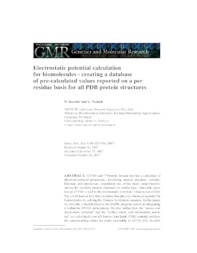Electrostatic potential calculation for biomolecules - creating a database of pré-calculated values reported on a per residue basis for all PDB protein structures.
Electrostatic potential calculation for biomolecules - creating a database of pré-calculated values reported on a per residue basis for all PDB protein structures.
Author(s): ROCCHIA, W.; NESHICH, G.
Summary: Abstract. STING and JavaProtein Dossier provide a collection of physical-chemical parameters, describing protein structure, stability, function, and interaction, considered one of the most comprehensive among the available protein databases of similar type. Particular attention in STING is paid to the electrostatic potential. It makes use of DelPhi, a well-known tool that calculates this physical-chemical quantity for biomolecules by solving the Poisson Boltzmann equation. In this paper, we describe a modification to the DelPhi program aimed at integrating it within the STING environment. We also outline how the "amino acid electrostatic potential" and the "surface amino acid electrostatic potential" are calculated (over all Protein Data Bank (PDB) content) and how the corresponding values are made searchable in STING_DB. In addition, we show that the STING and JavaProtein Dossier are also capable of providing these particular parameter values for the analysis of protein structures modeled in computers or being experimentally solved, but not yet deposited in the PDB. Furthermore, we compare the calculated electrostatic potential values obtained by using the earlier version of DelPhi and those by STING, for the biologically relevant case of lysozyme-antibody interaction. Finally, we describe the STING capacity to make queries (at both residue and atomic levels) across the whole PDB, by looking at a specific case where the electrostatic potential parameter plays a crucial role in terms of a particular protein function, such as ligand binding.
Publication year: 2007
Types of publication: Journal article
Observation
Some of Embrapa's publications are published as ePub files. To read them, use or download one of the following free software options to your computer or mobile device. Android: Google Play Books; IOS: iBooks; Windows and Linux: Calibre.
Access other publications
Access the Agricultural Research Database (BDPA) to consult Embrapa's full library collection and records.
Visit Embrapa Bookstore to purchase books and other publications sold by Embrapa.

